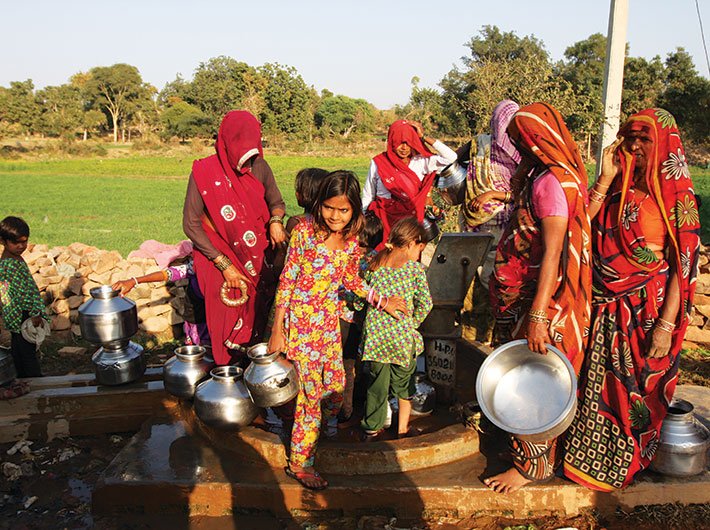... and of planning to counter it. Climate change and economic growth will worsen water shortage, says an MIT study. But there are solutions – even now
One billion people will be facing severe water shortage in India and neighbouring areas by 2050 thanks to climate change and expansion of economic growth, according to a projection made by the researchers of Massachusetts Institute of Technology (MIT). Their new study says that in future it would be growth rather than climate change which would be more responsible for water stress.
The study has projected the entire Ganga and Brahmaputra basins undergoing severe water stress 35 years from now thanks to both climate and economic growth. In the case of the latter, the culprit would be growth rather than climate, the study published on March 30 in PLOS ONE says.
Says Adam Schlosser, a senior research scientist and deputy director at MIT’s Joint Program on the Science and Policy of Global Change, who is a co-author of the study: “It is not just a climate change issue.’’ He says that economic changes and population growth (perhaps due to migration) could be stronger reasons for water stress in times to come. It also has to do with management of river basins.
Interview | There is a water emergency now: Rajendra Singh
The study, which has recommended more aggressive water policies and regulations in areas facing water stress, uses a network of water basins to simulate water stress scenarios.
The report comes at a time when 11 states in the country including all the southern states are reeling under severe drought and ‘water man’ Rajendra Singh has proposed a water security bill to address the scarcity.
Indian experts say we do not have to wait for 35 years for catastrophic conditions – they are already here and the future is unthinkable if no action is taken.
Large swathes of the country are reeling under drought, cattle are being left to fend for themselves, and more and more farmers are killing themselves.
Imagine the scenario in Maharashtra, which is currently wilting under drought, just four percent of the crop area consumes 75 percent of water. This is because farmers have turned to planting water-intensive sugarcane.
Says RH Sawkar, secretary of the Bengaluru-based Geological Society of India, who has also contributed to the draft of the proposed water security bill, “Unless a law restricts growth of water-intensive crops to certain areas, this overexploitation of water would go on. While sugar is available for just '25 a kg, we pay more than '100 for a kg of pulses as they are not grown as much as sugarcane. In fact when we export sugar, we are exporting water.”
But who can drive home this bitter truth to policymakers and politicians, he asks.
But not everything is dismal on the water front. One of the key features relates to recharging dead rivers and tapping surplus water in the Sahyadri range. It occupies 12 percent of total peninsular India but it receives 75 percent of precipitation, that is, water flowing from rivers and rain. Of this 42 percent goes into rivers, while most of the rest flows into the sea.
How can this water be used to enable equitable distribution of water in the south flowing rivers? “The bill tries to answer this question to some extent,” says Sawkar.
The other problem area is rivers which do not flow or turn into ghosts mid way through the year. Tungabhadra river in Karnataka is a case in point. It does not flow for six months. If this continues its tributaries, Tunga and Bhadra, would dry up permanently, says Sawkar.
So, how can one maintain the base flow of a river? This is another question that the water Bill looks at.
According to Sawkar the Bill proposes that water flow be stopped at the higher reaches in the micro basins and sub basins before it reaches the main basin of any river.
So, when it rains in June and July, what usually happens, for instance, with the Krishna river is that water from the streams in the higher reaches flows down to the sub basin of Bhima and then to the main Krishna river basin. This causes the streams and sub basins to dry up.
Similarly, in the case of the river Tungabhadra, the upperflow in the rain from the streams flows down into sub basins Tunga and Bhadra and the upperflow then flows down to the main basin of Tungabhadra. So the sub basins dry up quickly, Sawkar explains.
Only underflow, which is the ground water, should be permitted to flow to the next basin, says Sawkar. For this upper flow at higher reaches should be arrested with check dams and boulder dams. Only water that exceeds the dams should flow while ground water or underflow can always continue. Sawkar’s suggestion is also part of the Bill.
Echoing Sawkar, Schlosser of MIT notes, “What happens upstream affects downstream basins.” If climate change lowers the amount of rainfall near upstream basins while the population grows everywhere, then basins farther from the initial water shortage would be affected more acutely.
“Mitigation and adaptation practices, such as more efficient irrigation technologies, can reduce the future risk of high water stress,” Schlosser says. “Our preliminary findings indicate strong cases for effective actions and measures to reduce risk.”
This is what our water activists and geologists are also trying to say. Is anyone listening?
Menon is a freelance journalist.
(The article appears in the May 16-31, 2016 issue)



